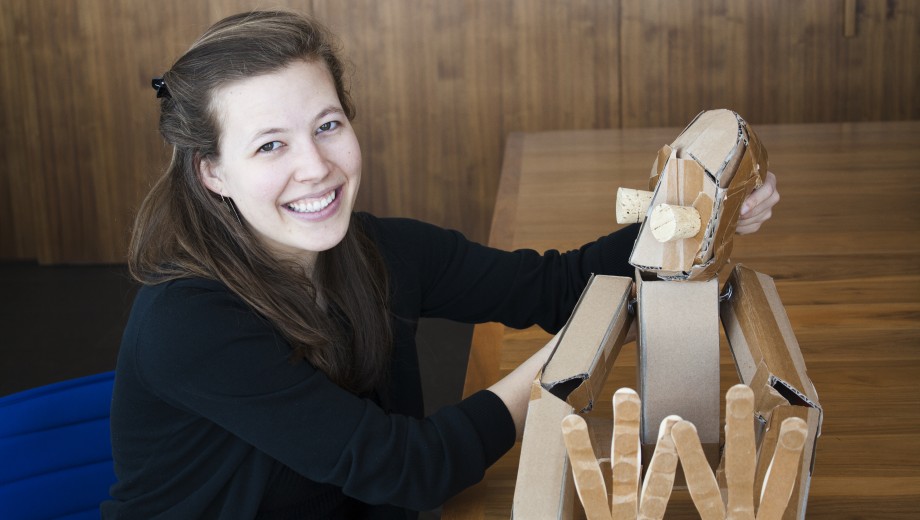There’s much more to puppetry than a performer and a prop, says Marissa Fenley. As a joint doctoral student in English Language and Literature and Theater and Performance Studies who grew up making puppets in an artistic family, Fenley studies the power dynamics of the art onstage and in literature.
Examining puppetry in twentieth- and twenty-first-century theater, television, film, and literature, she considers the particular mechanics of different styles, like ventriloquism and marionette shows, and analyzes how techniques influence the intimate relationship between puppet and puppeteer, as well as with other puppets and the audience. Fenley’s first dissertation chapter examines ventriloquism through the lens of race, pedagogy, therapy, and motherhood.
As literary metaphor, ventriloquism is shorthand for erasing the complexity of another’s voice and amplifying your own, relying on the idea of an all-powerful manipulator and a disenfranchised other. The mechanics of performance, however, create additional complexity. By lifting their hard palate to widen the vocal cavity, ventriloquists create the aural illusion of distance, producing what’s called a “drone voice,” Fenley says. That distancing influences the relationship between the ventriloquist and the dummy.
“The vent can swallow the voices of others while simultaneously asserting the ventriloquist’s nonidentification with them,” she says. “He does not have to bear the mark of difference on his own skin in order to internalize otherness.” However, through different case studies, Fenley shows that the power differential is mutable.
Fenley had become interested in the academic analysis of ventriloquism when she attended an annual ventriloquist convention in northern Kentucky. There she visited a museum dedicated to the history of the practice, where American ventriloquism’s origins were made explicit: minstrelsy, a tradition relying heavily on racist caricatures of African Americans. The dummy appeared around the time minstrel shows moved to vaudeville, with its “cross contamination” of traditions. Minstrel motifs were prominently displayed, and that heritage was “reanimated by everyone at this convention,” she says, “but never mentioned.”
Race remains central to American ventriloquism. Fenley cites two contemporary White entertainers as examples of minstrel ventriloquists. Terry Fator uses a Black dummy named Julius, who is a talented soul singer, which of course Fator is himself. “He’s implicitly saying, ‘I can be soulful; I can access what I’m assuming to be the property of Blackness,’” says Fenley. “But Fator doesn’t want to completely access racial difference because it would undermine his power.”
Jeff Dunham has a whole roster of dummies embodying racial and ethnic stereotypes while he plays the straight man. Like Fator’s, his performances “amplify a normative, apolitical White body in comparison to a politicized, racialized, highly controversial dummy body,” says Fenley. “If you analyze their jokes, it’s clear that they’re interested in defining Whiteness. There’s all sorts of ways they try to deny their investment in White supremacy, but it isn’t disguised.” They so blatantly borrow from minstrelsy’s techniques and iconography that it makes no sense to pretend otherwise, she says. In the power struggle between minstrel ventriloquists and their dummies, the performers don’t lose their White voice; they create a racialized voice to intensify their own.
To represent the teacher-student dynamic, Fenley uses one of the most famous American ventriloquist acts: Shari Lewis and her sock puppet Lamb Chop. They first appeared in a 1956 episode of Captain Kangaroo during a time when education theory began incorporating fun as an important aspect of childhood learning. Lewis was a founder of pedagogical puppetry.
“Pedagogical ventriloquism is faced with a particular problem,” says Fenley: “how to use the dummy to teach how not to be dummies.” In traditional modes of education, the student gains autonomy through knowledge. In contrast, “ventriloquism is an art of arrested development,” and the dummy never becomes autonomous. Children are supposed to learn the lesson the dummy can’t grasp.
But Lewis actually uses Lamb Chop to encourage children to stay children, addressing a new phenomenon of that era—working mothers. Lewis’s close connection with her sock puppet is meant to show that “attachments can be stable,” Fenley says, “even if they entail fluctuation and temporary disappearance.”
English avant-garde ventriloquist and comedian Nina Conti and her puppet Monkey serve as the case study for the therapist-patient relationship. Fenley notes a cultural association between ventriloquism and psychiatric disorders. What “leaks out” from the ventriloquist’s lips, into the puppet, might represent repressed feelings that provide access to self-knowledge.
In Conti’s therapy-based web series, Monkey is a representation of Conti’s inner mind—but Monkey’s “leaky mouth” provides no meaningful self-realization. Although early in the series Conti claims that Monkey can “say the unsayable,” she later says that what leaks out “is not the stuff you cannot normally say but should, but the stuff that does not need to be said in the first place.”
Fenley also uses Conti to explore the mother-fetus interaction. “Pregnancy for her is similar to ventriloquism in that the fetus and mother are entangled,” says Fenley, “especially an unwanted pregnancy, where who gets to matter in a scene is constantly under negotiation.”
In one act, Conti uses ventriloquism to explore the power dynamics of unwanted pregnancy, with Monkey entering her life on the day her child would have been born. In one of their stage acts, when Monkey hypnotizes Conti into sleep, he realizes he can’t speak without her and must bludgeon her awake, demonstrating that for one to have a voice, the other must give, and therefore lose, theirs. For Conti, unwanted pregnancy is a relationship that is a continued state of being mutually and violently dependent.
Fenley’s latest research focuses on the use of puppetry in protest, which she believes provides a visual anchor for a diffuse set of actors and beliefs. She will also investigate avant-garde marionettes and other anthropomorphic puppets to further investigate how the mechanics of their performances illustrate the dynamics of intimate relationships.

